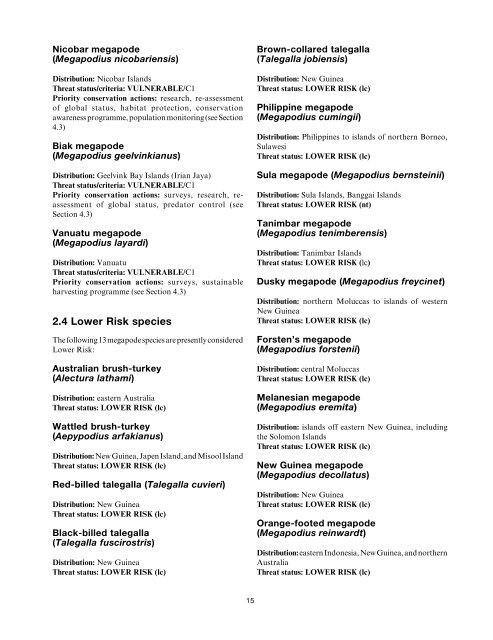Megapodes: Status Survey and Conservation Action Plan ... - IUCN
Megapodes: Status Survey and Conservation Action Plan ... - IUCN
Megapodes: Status Survey and Conservation Action Plan ... - IUCN
Create successful ePaper yourself
Turn your PDF publications into a flip-book with our unique Google optimized e-Paper software.
Nicobar megapode<br />
(Megapodius nicobariensis)<br />
Distribution: Nicobar Isl<strong>and</strong>s<br />
Threat status/criteria: VULNERABLE/C1<br />
Priority conservation actions: research, re-assessment<br />
of global status, habitat protection, conservation<br />
awareness programme, population monitoring (see Section<br />
4.3)<br />
Biak megapode<br />
(Megapodius geelvinkianus)<br />
Distribution: Geelvink Bay Isl<strong>and</strong>s (Irian Jaya)<br />
Threat status/criteria: VULNERABLE/C1<br />
Priority conservation actions: surveys, research, reassessment<br />
of global status, predator control (see<br />
Section 4.3)<br />
Vanuatu megapode<br />
(Megapodius layardi)<br />
Distribution: Vanuatu<br />
Threat status/criteria: VULNERABLE/C1<br />
Priority conservation actions: surveys, sustainable<br />
harvesting programme (see Section 4.3)<br />
2.4 Lower Risk species<br />
The following 13 megapode species are presently considered<br />
Lower Risk:<br />
Australian brush-turkey<br />
(Alectura lathami)<br />
Distribution: eastern Australia<br />
Threat status: LOWER RISK (lc)<br />
Wattled brush-turkey<br />
(Aepypodius arfakianus)<br />
Distribution: New Guinea, Japen Isl<strong>and</strong>, <strong>and</strong> Misool Isl<strong>and</strong><br />
Threat status: LOWER RISK (lc)<br />
Red-billed talegalla (Talegalla cuvieri)<br />
Distribution: New Guinea<br />
Threat status: LOWER RISK (lc)<br />
Black-billed talegalla<br />
(Talegalla fuscirostris)<br />
Distribution: New Guinea<br />
Threat status: LOWER RISK (lc)<br />
Brown-collared talegalla<br />
(Talegalla jobiensis)<br />
Distribution: New Guinea<br />
Threat status: LOWER RISK (lc)<br />
Philippine megapode<br />
(Megapodius cumingii)<br />
Distribution: Philippines to isl<strong>and</strong>s of northern Borneo,<br />
Sulawesi<br />
Threat status: LOWER RISK (lc)<br />
Sula megapode (Megapodius bernsteinii)<br />
Distribution: Sula Isl<strong>and</strong>s, Banggai Isl<strong>and</strong>s<br />
Threat status: LOWER RISK (nt)<br />
Tanimbar megapode<br />
(Megapodius tenimberensis)<br />
Distribution: Tanimbar Isl<strong>and</strong>s<br />
Threat status: LOWER RISK (lc)<br />
Dusky megapode (Megapodius freycinet)<br />
Distribution: northern Moluccas to isl<strong>and</strong>s of western<br />
New Guinea<br />
Threat status: LOWER RISK (lc)<br />
Forsten’s megapode<br />
(Megapodius forstenii)<br />
Distribution: central Moluccas<br />
Threat status: LOWER RISK (lc)<br />
Melanesian megapode<br />
(Megapodius eremita)<br />
Distribution: isl<strong>and</strong>s off eastern New Guinea, including<br />
the Solomon Isl<strong>and</strong>s<br />
Threat status: LOWER RISK (lc)<br />
New Guinea megapode<br />
(Megapodius decollatus)<br />
Distribution: New Guinea<br />
Threat status: LOWER RISK (lc)<br />
Orange-footed megapode<br />
(Megapodius reinwardt)<br />
Distribution: eastern Indonesia, New Guinea, <strong>and</strong> northern<br />
Australia<br />
Threat status: LOWER RISK (lc)<br />
15
















